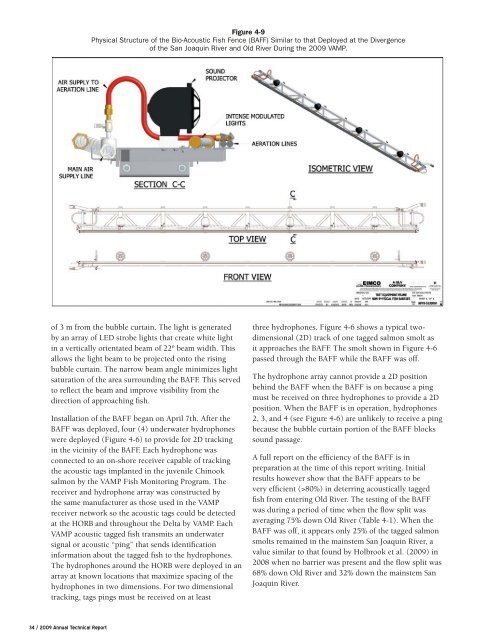Head OF Old riVer Barrier installatiOn and FlOWs - San Joaquin ...
Head OF Old riVer Barrier installatiOn and FlOWs - San Joaquin ...
Head OF Old riVer Barrier installatiOn and FlOWs - San Joaquin ...
You also want an ePaper? Increase the reach of your titles
YUMPU automatically turns print PDFs into web optimized ePapers that Google loves.
of 3 m from the bubble curtain. The light is generated<br />
by an array of LED strobe lights that create white light<br />
in a vertically orientated beam of 22º beam width. This<br />
allows the light beam to be projected onto the rising<br />
bubble curtain. The narrow beam angle minimizes light<br />
saturation of the area surrounding the BAFF. This served<br />
to reflect the beam <strong>and</strong> improve visibility from the<br />
direction of approaching fish.<br />
Installation of the BAFF began on April 7th. After the<br />
BAFF was deployed, four (4) underwater hydrophones<br />
were deployed (Figure 4-6) to provide for 2D tracking<br />
in the vicinity of the BAFF. Each hydrophone was<br />
connected to an on-shore receiver capable of tracking<br />
the acoustic tags implanted in the juvenile Chinook<br />
salmon by the VAMP Fish Monitoring Program. The<br />
receiver <strong>and</strong> hydrophone array was constructed by<br />
the same manufacturer as those used in the VAMP<br />
receiver network so the acoustic tags could be detected<br />
at the HORB <strong>and</strong> throughout the Delta by VAMP. Each<br />
VAMP acoustic tagged fish transmits an underwater<br />
signal or acoustic “ping” that sends identification<br />
information about the tagged fish to the hydrophones.<br />
The hydrophones around the HORB were deployed in an<br />
array at known locations that maximize spacing of the<br />
hydrophones in two dimensions. For two dimensional<br />
tracking, tags pings must be received on at least<br />
34 / 2009 Annual Technical Report<br />
Figure 4-9<br />
Physical Structure of the Bio-Acoustic Fish Fence (BAFF) Similar to that Deployed at the Divergence<br />
of the <strong>San</strong> <strong>Joaquin</strong> River <strong>and</strong> <strong>Old</strong> River During the 2009 VAMP.<br />
three hydrophones. Figure 4-6 shows a typical twodimensional<br />
(2D) track of one tagged salmon smolt as<br />
it approaches the BAFF. The smolt shown in Figure 4-6<br />
passed through the BAFF while the BAFF was off.<br />
The hydrophone array cannot provide a 2D position<br />
behind the BAFF when the BAFF is on because a ping<br />
must be received on three hydrophones to provide a 2D<br />
position. When the BAFF is in operation, hydrophones<br />
2, 3, <strong>and</strong> 4 (see Figure 4-6) are unlikely to receive a ping<br />
because the bubble curtain portion of the BAFF blocks<br />
sound passage.<br />
A full report on the efficiency of the BAFF is in<br />
preparation at the time of this report writing. Initial<br />
results however show that the BAFF appears to be<br />
very efficient (>80%) in deterring acoustically tagged<br />
fish from entering <strong>Old</strong> River. The testing of the BAFF<br />
was during a period of time when the flow split was<br />
averaging 75% down <strong>Old</strong> River (Table 4-1). When the<br />
BAFF was off, it appears only 25% of the tagged salmon<br />
smolts remained in the mainstem <strong>San</strong> <strong>Joaquin</strong> River, a<br />
value similar to that found by Holbrook et al. (2009) in<br />
2008 when no barrier was present <strong>and</strong> the flow split was<br />
68% down <strong>Old</strong> River <strong>and</strong> 32% down the mainstem <strong>San</strong><br />
<strong>Joaquin</strong> River.


